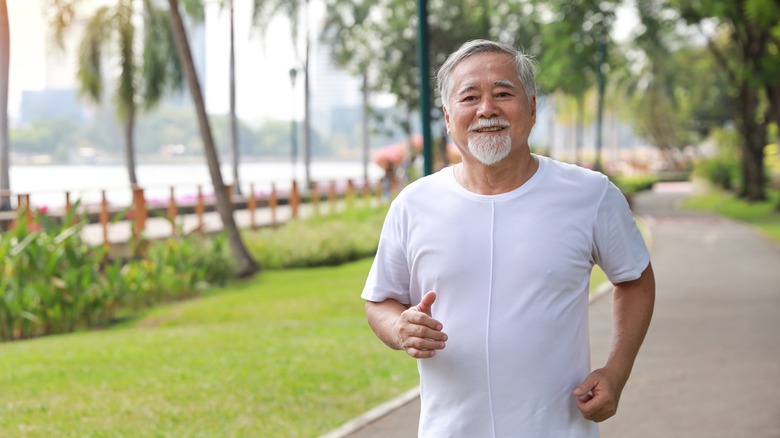Breaking Down The Viral Sit-To-Stand Test
If you're on TikTok, you've probably seen the viral sit-to-stand test — indeed, the challenge hashtag has garnered nearly 5 million views (via TikTok). People all over the world are challenging themselves to sit down on the floor and then stand up again to measure their longevity. If you can't do this, supposedly you have an elevated risk of dying within six years (via Today). But how did this challenge originate, and does it actually provide meaningful information about your health?
The sit-to-stand test was used as a measure of musculoskeletal fitness in a 2012 study in the European Journal of Preventative Cardiology, and researchers chose this test because it requires some degree of strength and balance to accomplish it. The researchers had 2,002 adults ranging from age 51 to 80 do the test, and participants were graded on a point system — all began with 10 points, and points were wholly or partially deducted depending on how the actions were performed (or not). Researchers then followed up about six years later. The people who had lower scores at the start of the study were more likely to have died by the six-year follow-up. Each point increase in the sit-to-stand test increased their later rate of survival by 21%. How well would you do in this challenge? Let's break it down.
How to do the sit-to-stand test
Although you might see people doing the sit-to-stand test in shoes, you'll need to do it barefoot on a non-skid surface in order to replicate the conditions of the 2012 study. Wearing restrictive clothing might inhibit your mobility, so wear something that will allow you to move in different angles and directions. The sit-to-stand test isn't timed, so don't worry about doing it too fast or too slow.
The sit-to-stand test is two actions. The first action is moving into a cross-legged seated position from a standing position. You can start standing with your legs crossed, cross them on your way down, or cross them when your bottom hits the floor. It's your choice. The second action is to stand up from this cross-legged position. Piece of cake, right? Here's the catch: You can't use any support, such as your hand or arm, to help you down or up. You can't even use your hand on the side of your leg as you sit or stand. It's all about testing the balance and strength of the legs and core.
To grade the test, you begin with 10 points: five maximum for the sitting portion, and five for the standing action. Anytime you use any support for either action, you lose a point. If you partially lose your balance, subtract half a point. For your total score, combine the point totals from both the sitting and standing actions. A perfect score is a 10. If you can't get up from the seated position, though, you receive zero points.
The sit-to-stand test isn't the only measure of longevity
Health experts tell Fortune that the sit-to-stand test is just one indicator of your health. Although a low score on the sit-to-stand test indicates low musculoskeletal fitness and can indicate poor health, other factors such as genetics and lifestyle also factor into your longevity. And, too, the test may not be applicable for every person at every time: For instance, if you have a leg injury or recently had knee surgery, it's understandable that you wouldn't be able to do the sit-to-stand test even if you're in otherwise good health.
Your walking pace can also indicate your longevity. A 2018 study in the British Journal of Sports Medicine found that among 50,000 subjects, those who walked at an average pace had a 24% reduced risk for cardiovascular disease and a 20% reduced risk for all-cause mortality compared to people who walked at a slower-than-average pace.
A 2022 study in the British Journal of Sports Medicine used a 10-second one-leg balance test to determine the longevity of more than 1,700 people between the ages of 51 and 75. The people who couldn't balance on a single leg for 10 seconds had a higher all-cause mortality rate than those who could successfully complete the test.
According to the University of Washington Medicine, working on your legs and core strength can reduce your risk of falls later in life. It's never too late — you can begin by taking more walks each week or adding yoga or tai chi into your exercise regime to improve your balance and core strength. The more you move now, the better you'll move later.


